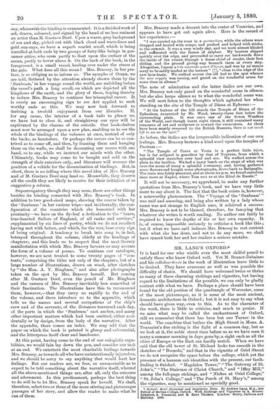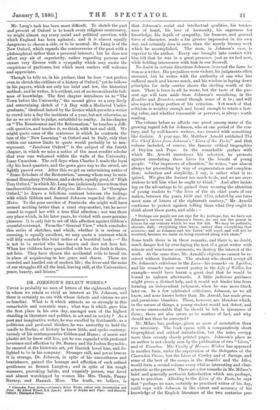MR. LANG'S OXFORD.*
IT is hard for one who wields even the most skilful pencil to satisfy those who know Oxford well. Yet M. Brunet-Debaines and his collaboroteurs in the work of illustration leave little to be desired. They have overcome as well as was possible the difficulty of choice. We should have welcomed twice or thrice as many of these charming etchings and vignettes, but having regard to the limitations of the possible, we can only be gladly content with what we have. Perhaps a place should have been found for the old portion of the quadrangle of Worcester, some of the most picturesque, as it is some of the most ancient, domestic architecture in Oxford; but it is not easy to say what should have given way, even to this. As to the character of the work, there is little to criticise, and much to praise. If we miss what may be called the enchantment of Oxford, still we remember that there has been but one Turner in the world. The sunshine that bathes the High Street in Mons. A. Toussaint's fine etching is the light of a common day, but as we look at it, the noble street rises before us as we have seen it many a summer morning in days gone by, a sight such as all the cities of Europe or the East can hardly match. When we have said that the old tower of St. Michael looks too smooth in the sketches of " Bocardo," and that in the vignette of Oriel Street we do not recognise the space before the college, which yet the presence of a hansom cab identifies with the present, our fault- finding is finished. "Magdalen Tower," "The Gateway of St. John's," "The Staircase of Christ Church," and " Iffiey Mill," among the full-page etchings, and "Niches at Oriel College," "St. John's College," and "The Porch of St. Mary's," among the vignettes, may be mentioned as specially good.
* War d : Brief Historical and Descriptire Notes. By Andrew Lang, M.A, late Fellow of Merton College, Oxford. With Etchings and Vignettes by A. Brunet- Debaines, A. Toussaint., and B. Kent Thomas. London: Seeley, Jackson and Halliday. 1880.
Mr. Lang's task has been more difficult. To sketch the past and present of Oxford is to touch every religions controversy, we might almost say every social and political question, with -which England has been agitated; and it is almost equally dangerous to choose a side, or to be neutral. Mr. Lang is of the New Oxford, which regards the controversies of the past with a philosophical rather than a personal interest ; but he does not -affect any air of superiority, rather regarding persons and causes very diverse with a sympathy which may excite the suspicions of partisans, but which most readers will welcome and appreciate.
Though he tells us, in his preface, that he does "not profess -even to sketch the outlines of a history of Oxford," yet he follows in his papers, which are only too brief and few, the historical method; and he writes, it is evident, out of no inconsiderable full- ness of knowledge. The first chapter introduces us to "The Town before the University," the second gives us a very lively and entertaining sketch of "A Day with a Medi-eval Under- graduate," idealised indeed by the licence which permits a writer to crowd into a day the incidents of a year, but not otherwise, as far as we are able to judge, unfaithful to reality. In his chapter on "The Renaissance and the Reformation," he touches a diffi- cult question, and touches it, we think, with tact and skill. We might quote some of the sentences in which he contrasts the fate of the "New Learning" at Oxford and in Italy, only that within our narrow limits to quote would probably be to mis- represent. "Jacobean Oxford" is the subject of the fourth chapter, in which we miss a notice of the most erudite scholar that ever was welcomed within the walls of the University, Isaac Casaubon. The evil days when Charles I. made the loyal city his head-quarters, and the gown gave way to the sword, are lightly passed over. After this we get an entertaining notice of -" Some Scholars of the Restoration," among whom may be men- tioned Humphrey Prideaux, and a sketch, equally good, of "High Tory Oxford," in which Mr. Lang has judiciously drawn from that inexhaustible treasure, the Reliquiae Hernianae. In "Georgian Oxford," he draws a felicitous contrast between the feelings -with which Gibbon and Samuel Johnson regarded their Alma Mater. To the poor servitor of Pembroke she might well have seemed nothing better than a cruel step-mother, but he never -ceased to regard her with a true filial affection ; nor was there any place which, in his later years, he visited with more genuine pleasure. It is only fair to set off this affection against Gibbon's scornful contempt. From the" General View," which concludes this series of sketches, and which, whether it is serious or amusing, is equally excellent, we may quote a sentence which will fitly conclude this brief notice of a beautiful book :—" He is not to be envied who has known and does not love her. When her children have quarrelled with her, the fault is theirs, not hers. They have chosen the accidental evils to brood on, in place of acquiescing in her grace and charm. These are crowded and hustled out of modern life ; the fever and the noise of our struggles fill all the land, leaving still, at the Universities, peace, beauty, and. leisure."











































 Previous page
Previous page